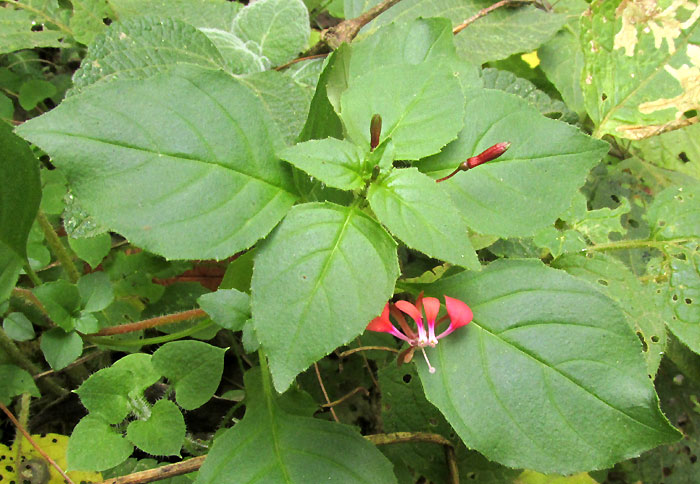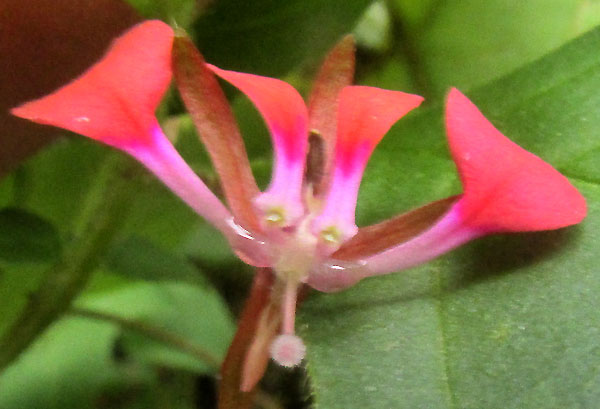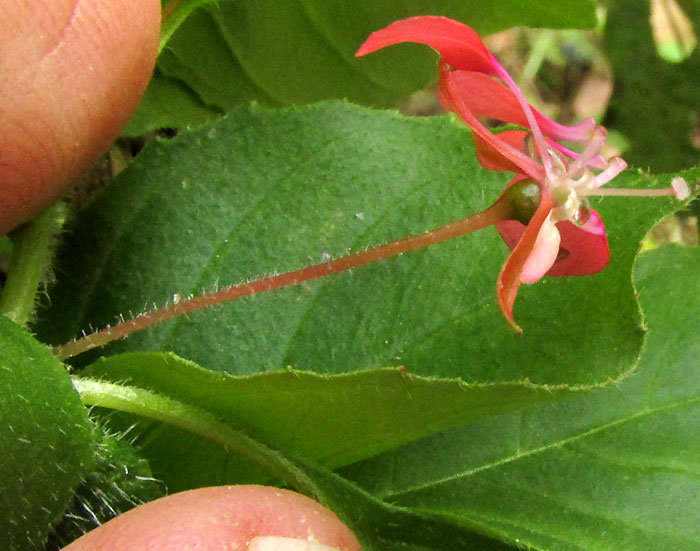Excerpts from Jim Conrad's
Naturalist Newsletter
entry from field notes dated January 19, 2023, taken along steep, one-lane gravel road ascending forested, northeast-facing mountain slope, elevation ±2,380m (7600 ft); bedrock of Cretaceous limestone; on the south side of Pinal de Amoles, Querétaro state, MÉXICO, (N21.134°, W99.629°)
MOSQUITO FLOWER

On the shady side of the mountain, in a chopped-over spot beside a steep gravel road, the above cherry-sized eruption of bright red was hard to miss amid all the greenness. Up close, the flower was very distinctive:

Very bilaterally symmetrical, almost like a humorous caricature of a startled human face, the corolla consisted of four red petals, below which four more long, slender and reddish-brown sepals arose. Each of the two upper, smaller petals bore a single gland, at the side of which arose a small projection of the petal base, an auricle. The larger petals at their bases display drops of liquid, presumably nectar from the above glands. Below the corolla there's the slender style tipped with a spherical white stigma. From the side, more structures can be seen:

The above photo is somewhat confusing. It's clear that at the image's right border the white, oblong shape is the stigma atop its long, slender style. It looks like one or two red petals have come loose and are stuck out of place. To understand more, it's necessary to know what kind of plant this is.
With four sepals and four brightly colored petals, and the stamens, petals and sepals arising above the ovary -- as seen in the above photo -- one thinks of the Evening Primrose Family, the Onagraceae. Within that family, it turns out that what we have is fairly exceptional. While Onagraceae flowers usually bear four or more stamens, our plant's flowers produce only two, of which one is petal-like and sterile -- it's a "staminode." In the flower bud the staminode wraps around the fertile stamen's anther.
With this observation, and the fact that our blossom is strongly bilaterally symmetrical, we're led to the genus Lopezia, occurring only from Mexico south to Panama.
Knowing that we have a Lopezia, thanks to a 1973 publication by Uzi Plitmann and others, entitled "The Systematics of Lopezieae (Onagraceae)," with regard to the strange stamens we can say that when our Lopezia flower opens, its petal-like sterile stamen "snaps" downward. In the above photo, the conspicuous white bulge appearing to lie on the flat surface of the sepal below it, is the snapped-down sterile stamen. Above the horizontal style, we see two white, up-curving, fingerlike items. I think the top one is the fertile stamen, which bends upward after it sheds pollen, before the female parts are receptive.
Peter Raven in his 1979 paper entitled "A survey of reproductive biology in Onagraceae" comments on the snapping stamens of Lopezia: "... the fertile stamen is enfolded by the spoon-shaped sterile stamen and held under tension, discharging its pollen explosively on the lower side of insects visiting the flower."
I can't say what the fingerlike item between the picture's fertile stamen and the style is -- maybe part of a dislodged petal.
At this time about 28 Lopezia species are recognized, of which three have been documented in the semiarid uplands of central Mexico known as the Bajío Region, of which we are part. In our area, if you have Lopezia as hairy as our plant, and at each of the bases of the two upper petals there's just one gland, not two, you have LOPEZIA RACEMOSA subspecies RACEMOSA.
Lopezia racemosa occurs from northern Mexico south to El Salvador, while our subspecies racemosa is found just within Mexico, from the state of Tamaulipas in the north to Chiapas in the south. It inhabits various habitats, from oak-pine forests to grasslands, along streams and in moist ravines. Though the species occurs in no English speaking country, in English Lopezia species often are referred to as Mosquito Flowers.
Lopezia flowers are pollinated by hummingbirds, syrphid flies and only rarely bees, bees normally being unable to gather pollen from the snapping fertile anthers.
In the online "Atlas de las Plantas de la Medicina Tradicional Mexicana", Lopezia racemosa is described as useful in a number of cures ranging from stomach ache, to nausea, to bathing a mother and baby after childbirth. In fact, the 2019 study by Enrique Vergara Barragán and others entitled "Bioactivities of Flavonoids from Lopezia racemosa" comes to the conclusion that "... the methanolic fractions isolated from the leaves and flowers of L. racemosa showed antibacterial and antifungal activities, supporting its use in traditional medicine"
Elsewhere it's documented that pigs and burros eat it.